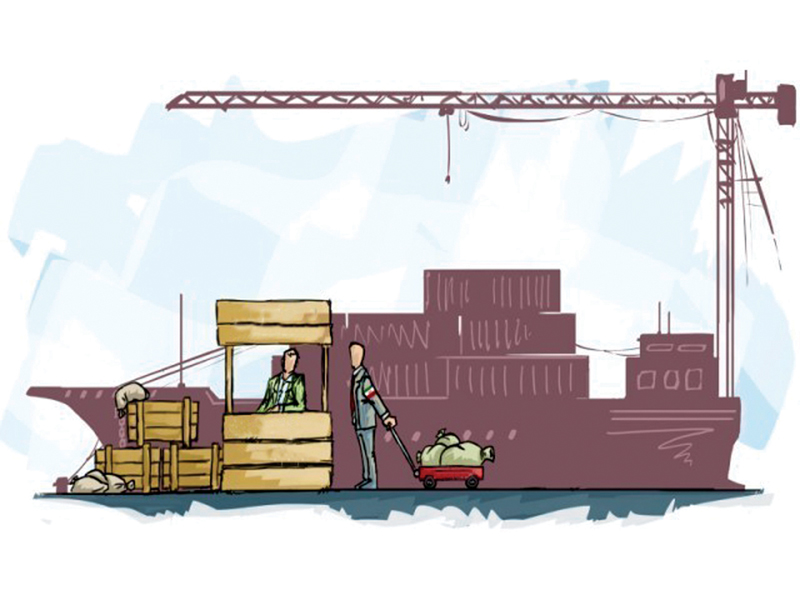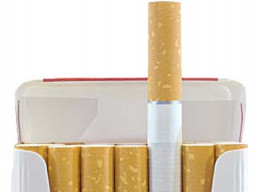
It was not supposed to have been this way. After the European Union granted GSP Plus Status to Pakistan, our exports were supposed to have risen sharply, yet instead, Pakistan’s sale of goods to the outside world have gone down by 4.3% during the first half of fiscal 2015. What is happening? What is causing this decline in exports?
There are three possible explanations for the slowdown in exports. The first is that Pakistan’s major export markets – the United States, the European Union, China and the Middle East – are experiencing an economic slowdown. The second is that the energy crisis is causing exporters to struggle to meet the demand from importers. And the third possible explanation is idiosyncratic factors that are not connected to systemic issues.

The first possibility – a slowdown in Pakistan’s export partners’ economic growth – is a double-edged sword. On one hand, it means that the decline in Pakistan’s exports is not the fault of our industries, but on the other hand, it also means that there is nothing to be done but wait for economic conditions in our export markets to improve. So is this happening? A look at the data released by the Pakistan Bureau of Statistics suggests that this is only a partial explanation.
Of the four major regions to which Pakistan exports, two are regions experiencing a slowdown in economic growth: China and the European Union. The data shows a mixed picture. During the period through August 2014 (the latest month for which data by country is available) Pakistan’s exports to the European Union increased by 5.8%, while exports to China declined by 30.8%. The GSP Plus status that Pakistan was granted by the EU clearly seems to be working: despite the slowdown in European economic growth, Pakistan’s exports to the region are rising. Meanwhile, China’s economic torpor is making its presence felt sharply on Pakistani exporters’ financial health.
The explanation favoured by many in the textile lobby is that the energy crisis, particularly in Punjab, has significantly reduced the industry’s production capacity and caused a decline in exports. There is at least some evidence to support this hypothesis. In the five months between July and November 2014 (the latest for which data by commodity group is available), textile exports rose by just under 1% in value. However, a look at the quantity suggests that the picture was far from rosy.
Exports of raw cotton and cotton yarn are down 2% and 1% respectively compared to the same period in the previous year. For cotton cloth, the picture is even worse: export quantities are down 32.6% compared to the same period last year. However, towels, knitwear and bedwear exports are all up both in quantity and dollar value exported, suggesting that those further up the value chain are more immune to energy-related issues than those who produce more basic commoditised products.
The energy crisis is no doubt a severe impediment to several companies, but it hits the relatively inefficient spinning and weaving industries within the textile sector far worse than it affects the composite textile sector. Textile exports are largely flat, mainly due to higher prices this year compared to last, but the data suggests that Pakistani exports could have been much higher had the export mix been more skewed towards value-added products.
The final explanation, meanwhile, is the more complicated one: idiosyncratic changes in the environment in many different industries that happen to be affecting exports. The data does seem to support this hypothesis. Of the four major export categories used by the PBS – food, textiles, petroleum, and other manufactured goods – it is the last category that has seen a sharp 18.4% decline in value of exports, from $2 billion to $1.65 billion.
Jewellery exports have virtually collapsed, from over $200 million during July-November 2013 to less than $4 million during the same period in 2014. Leather exports, as well as chemical exports are down substantially, for reasons that have more to do with the specific circumstances in those industries than the broader Pakistani macroeconomy.
In short, the picture on trade – and therefore the policy requirement – is complex. Yes, the government could help a lot by fixing the energy crisis that would let more companies in more industries produce and export and full capacity. But the government would also do well to focus on more industries than just the politically powerful textile lobby.
The writer is a staff correspondent
Published in The Express Tribune, January 12th, 2015.
Like Business on Facebook, follow @TribuneBiz on Twitter to stay informed and join in the conversation.
COMMENTS (14)
Comments are moderated and generally will be posted if they are on-topic and not abusive.
For more information, please see our Comments FAQ

1730959638-0/trump-(19)1730959638-0-165x106.webp)















@Ali Salman:
Well said but this wont happen until we be become a developed country. For that we need major reforms both political and economic. Most imp is tax reform. We have the richest political elite and poor nation. Until this changes, we will depend on exports.
@Amir Investment by the industry (not economic planning initiatives) is needed to turn "high quality" finished products. Living in the West, one rarely sees a quality textile product made in Pakistan, usually it is undershirts and cheap T's or Golf shirts. China still provides high end quality textile products. Bangladesh, Sri Lanka, Indonesia and Indian high quality products are textile are also found. There are structural issues in Pakistan - no investment, no energy (there is not as much shortage of electricity in the Indian Punjab), stable economic and political climate. Incidentally, people pay $100 to $200 for Golf shirts made with new synthetic, breathable clothing like most sports players wear in Tennis, football and so on. And, it is not cotton.
The export driven economic policy is plain mercantilism. We must come out of it and explore domestic commerce. The reason of stagnant exports may be paradoxically restrictions on imports.
The Pakistani Rupee is cheap compared with other currencies, we should be able to achieve decent exports. But we need to exploit new markets in different countries.
Also should lower taxation on important firms that yield a significant percentage of revenue. While providing subsidies.
What really damages our Market is, they buy the 'Materials' and 'Building Resources' from us, turn it into a finish product and sell it at 5 times the original yield. Considering the cotton market, they buy the cheap materials, make them into finished goods then 'add-value' to the finished good, in-turn (we being foolish) buy the finished goods which are more costly than our cotton exports (5 times of revenue yields).
I mean what are the economic planners even doing in Pakistan? How un-professional can these guys get? Now's your time! Our currency is weak, get the profit yield and use it to your advantage, hurry!
The article misses a possible additional important factor, namely, competition.
I am Exporting Textiles from last 5 years.
i feel our export is declining because of the competition , and why we are facing competition because we cannot meet the buyer requirement ( Prices ) . however China, Taiwan , Bangladesh are still competing us.
we had the best quality we still have, but we cannot low down the rates,
WHY
because our basic expenditures are very high now, the labour cost is high because the increase in Fuel Prices which effects the basic food items.
petrol prices are high we get a high price for exporting shipments, which technically leads to Materials we buy to make textile item ready.
we can improve our exports like it was before, but we need to control our basic prices. Petrol, Food,
however on the other hand we are still exporting Surgical / Sports / Denim because the people who are exporting them have strong relationships with customers.
First afall the prices of petroleum products have gone down drastically thus in terms of VALVE the figures in coming days will be alarming. GSP plus status granted by EU not only to Pakistan but to other countries as well. FYI the counterveiling duty in most of our products has not been waived thus we are not competative in the global market. Pakistan on urgent basis need to takecare LAW & ORDER situation. The mafias backed by political backing are badly destroying our economy. Government has to put aside their personal interest for the betterment of this country. Situation is not complex, we have to come up with better policies.
A lot of textile units have moved to Bangladesh. Under this climate of rampant terrorism, few businessmen will risk their capital to expand.
Good reporting, but I am highly impressed with the high standard of comments. This is needed in other spheres too.
No mention at all of the exchange rate? The exchange rate is the only thing that explains falling exports AND rising imports.
After the European Union granted GSP Plus Status to Pakistan, our exports were supposed to have risen sharply . Except that your competitors were granted the same GSP Plus status so maintaining market share might have been a more logical goal. . In short, the picture on trade – and therefore the policy requirement – is complex. . Maybe - but it's not that complex. Pakistan is too reliant on textiles which is a highly competitive market and one that has practical capacity that tops out even in a booming economy (only so many clothes you can stuff into your closet). . If you want to expand your exports then you need to expand the production base - that requires massive foreign investment which will require a fundamental change in how foreign investors view Pakistan. Issues of extremism, corruption, and fair judiciary need to be resolved before that capital will flow.
Good analysis .
Value added exports is the key, both in manufacturing and services .
Good analysis .
Value added exports is the key, both in manufacturing and services .
I was long waiting for this topic to be addressed. However, I have a few concerns regarding the reasons presented: 1. Pakistan exports low value products (textiles are low value, A laptop is hi value). So our exports should NOT decrease even if the global economy has slowed down. 2. Energy crises - On a year on year basis, the situation might not have improved but it is not worse as compared to the last year.
A better way to look into this issue would be to conduct detailed interviews with people involved in export related businesses.